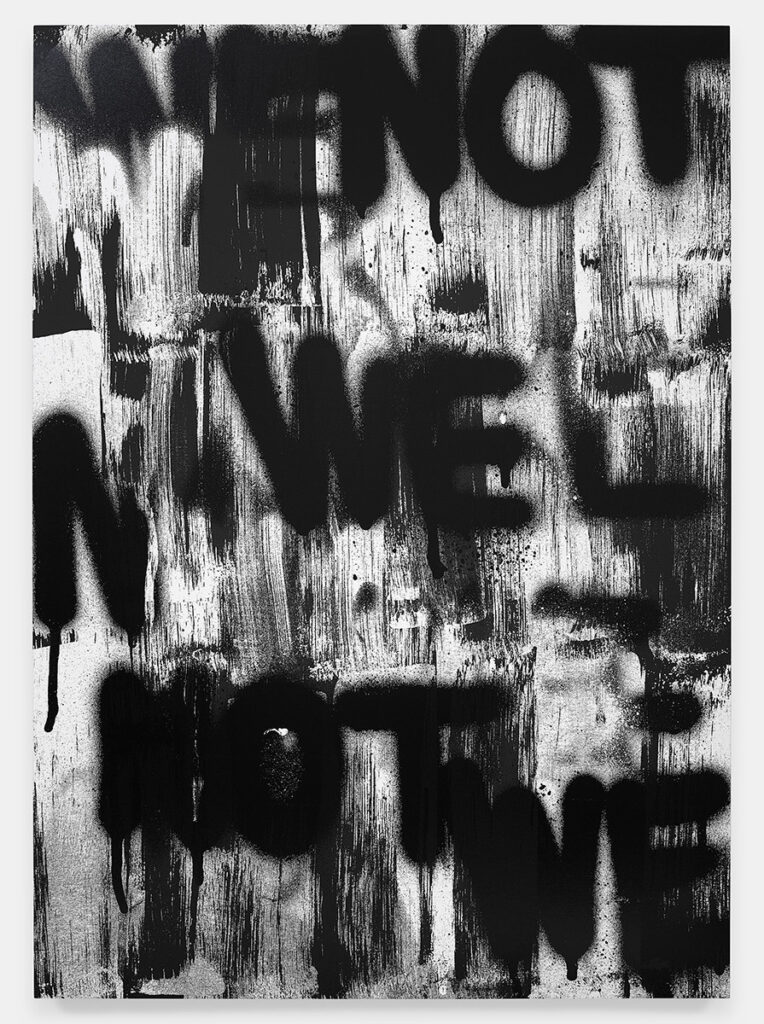
Pace is pleased to present An Abstraction, an exhibition of recent paintings and drawings by New York-based artist Adam Pendleton, at its 540 West 25th Street gallery in New York from May 3 to June 20.
Pendleton’s first solo show at Pace’s New York gallery in ten years, An Abstraction follows a series of significant solo exhibitions by the artist at museums around the world, including the Museum of Modern Art in New York in 2021; the Montreal Museum of Fine Arts in 2022; and mumok, Vienna in 2023. The return to his home city marks a continuation of his career-long project of creating spaces of engagement and “fighting for the right to exist in and through abstraction.”
Pendleton’s work indexes and documents the physical process of painting to create layered pictorial fields that—in their painterly, psychic, and verbal expressions—announce a new mode of visual composition for the 21st century. He is guided by a visual and structural philosophy he has termed “Black Dada,” an ongoing inquiry into Blackness and its relationship to abstraction and conceptions of the avant-garde. Investigating Blackness as a color and theoretical proposition, the artist’s work reflects a contrapuntal understanding of the world in both sensorial and conceptual terms.

In An Abstraction, the artist’s 12 paintings and 13 drawings will hang within a monumental, site-specific architecture consisting of five black triangular forms. These sculptural walls will reorder the gallery into new, unexpected spaces and extend the visual language of the exhibited works.
Bringing together the artist’s Black Dada and Untitled (Days) bodies of work, the new paintings and drawings in the exhibition feature a variety of marks—spray painting, stenciled geometric forms, and expressionistic brushstrokes—to blur distinctions between painting, drawing, and photography and propose painting as a documentary and performative act.
Pendleton’s new Black Dada works imbue his iconic black and white compositions with focused and saturated colors. Each of the paintings and drawings in this body of work bears one or more typographic letters from the phrase “BLACK DADA,” rendered in a sans serif font amid the artist’s gestural marks. Continually transposing and overwriting these two modes of inscription, Pendleton cultivates a living library of his own ever-evolving gestures and processes.

Paintings and drawings from Pendleton’s Untitled (Days) body of work will also be featured in An Abstraction. Using collagist strategies of indexing, daily mark-making, fragmentation, and recombination, these works create a cumulative portrait of the artist’s experimentations in the studio.
In spring 2025, the Hirshhorn Museum and Sculpture Garden in Washington, D.C. will present Love, Queen, a landmark exhibition of Pendleton’s work that will anchor the institution’s 50th anniversary year.
About the Artist


Born in Richmond, Virginia in 1984, Adam Pendleton completed the Artspace Independent Study Program in Pietrasanta, Italy, in 2002. His work has been featured at major museums around the world, including solo exhibitions at the Baltimore Museum of Art; Le Consortium, Dijon, France; Isabella Stewart Gardner Museum, Boston; KW Institute for Contemporary Art, Berlin; Museum of Contemporary Art Cleveland; and Museum of Contemporary Art Denver, among others.
Adam Pendleton’s work is a reflection of how we increasingly move through and experience the world on a sensorial level—a form of abstraction that, in its painterly, psychic, and verbal expression, announces a new mode of visual composition for the twenty-first century.
It investigates Blackness as a color, an identity, a method, and a political subject—in short, as a multitude. His work also poses questions about the legacy of modernism in the present day, reactivating ideas from historic avant-gardes across mediums and moments in time. Since 2008 he has articulated much of his work through the frame of Black Dada, an evolving inquiry into the relationships between Blackness, abstraction, and the avant-garde. It’s a visual philosophy that confounds the distinctions between legibility and abstraction, past and present, familiar and strange, reminding us that meaning always develops through difference.




